
Mastering the Art of Hole-Making in Microfluidic products
At Micronit, we're leading the way in microfluidic production. We're experts at helping our clients go from an idea to a real, working product, quickly and smoothly. One of the keys to making this happen is ensuring that the product design and the manufacturing process work well together. If they don't, it can lead to costly problems, delays, and even failed products. One of the most critical parts of this process is creating holes in glass microfluidic devices - it might seem simple, but getting it right can have a big impact on how well the final product works.
In this article, we're going to break down the ins and outs of creating holes in glass microfluidic devices. We'll start by discussing some common mistakes and how to avoid them. Then, we'll dive into the different ways to make holes, explaining the pros and cons of each method. Finally, we'll offer some tips on how to choose the best method for your needs. Whether you're already an expert in microfluidics, or you're just starting out, our aim is to provide a clear and simple guide to mastering the art of hole creation. So get ready to learn, as we take you through this important part of making successful microfluidic devices
Common Mistakes and Failures for holes in microfluidic products
In the manufacturing of microfluidic systems, numerous potential pitfalls can disrupt the desired outcome. Common issues such as uneven hole shapes, misplacement, and excessive hole wall roughness can arise. These errors can negatively affect the final product’s functionality and may even result in total device failure. To avoid such issues, choosing the correct hole creation techniques for microfluidic devices and understanding the workings of each process is essential. In the subsequent sections, we delve into some of the most effective hole creation methods in microfluidic devices, their unique benefits, and limitations. We also discuss key considerations when selecting the best hole-creation method for your unique needs, ensuring the successful execution of your microfluidic designs.
Methods for Crafting Perfect Holes in Microfluidic Products
There are multiple techniques to produce precise and high-quality holes in microfluidic devices. Effective methods include powder blasting, laser drilling, and laser-induced etching, each with its own set of advantages and limitations.
Powder Blasting:
Powder blasting is a mechanical process that involves blasting abrasive particles at high speeds onto the substrate to remove material and create holes. This method is suitable for making holes in a wide range of glass types. Powder blasting is particularly effective for creating wafers with a high density of holes. However, the roughness of the hole walls can be a drawback, and very small holes and sharp corners are more challenging to achieve with this technique.
This process always results in tapered holes. It will have a taper of around 15 to 30 degrees. The opening on the powderblasted side will have a larger diameter compared to the other side.
Advantages of powder blasting:
- Versatility: Powderblasting can accommodate various hole sizes and shapes, catering to diverse application requirements.
- Cost-effective: Compared to laser-based techniques powderblasting offers a more affordable option with a high density of holes.
Limitations of powder blasting:
- Rough edges: Powderblasting can result in rough edges around the created holes, requiring additional post-processing steps for smoother surfaces.
- Limited precision: Achieving high precision with powderblasting can be challenging due to factors such as particle size and impact force variation.
- The minimum hole size is a 200µm diameter.
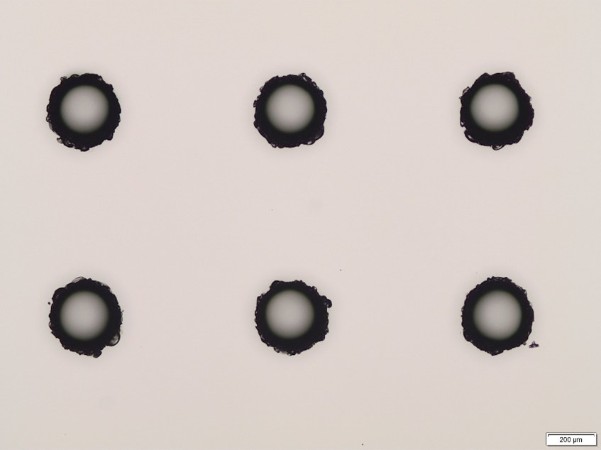
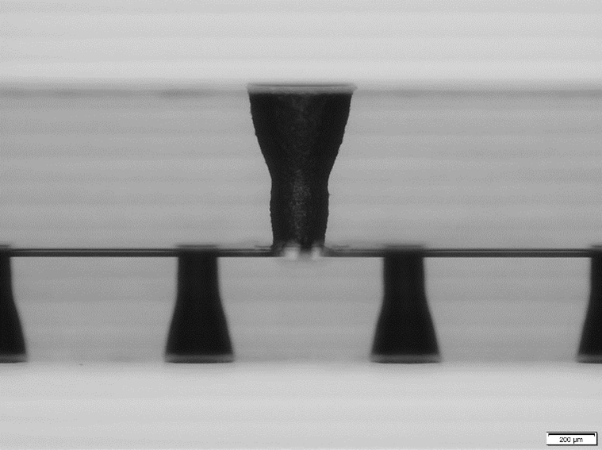
Left: 200µm diameter powderblasted; Right: Cross section of powderblasted holes
Laser ablation:
Laser ablation, also known as laser drilling, is a contactless process that uses a focused laser beam to remove material and create holes. This method is suitable for making small, precise holes. Laser drilling is effective for a wide range of glass types, including D263, Borofloat and Mempax.
This technique can achieve aspect ratio’s of 1:10 with a minimum hole size of 100µm diameter. There are even possibilities to go down to 50µm when needed. The process is a sequential process, so if the design contains a high hole density , this process will be less attractive. Depending on wafer volumes, this can still be favorable. Micronit can help you making this choice.
Advantages of laser ablation:
- High precision: Laser ablation enables the creation of highly accurate and well-defined holes with micron-level precision.
- Minimal material waste: Laser ablation is a non-contact process, ensuring minimal material waste and reduced contamination.
- Minimal post-processing: The holes created by laser ablation don't need any masking or protection, eliminating the need for pre- or post prossing steps.
Limitations of laser ablation:
- Chipping: similar to powderblasting, chipping occurs at the edges of the holes,
- Materials: The process is limited to the borosilicate glass types. Fused Silica is not yet possible to process.
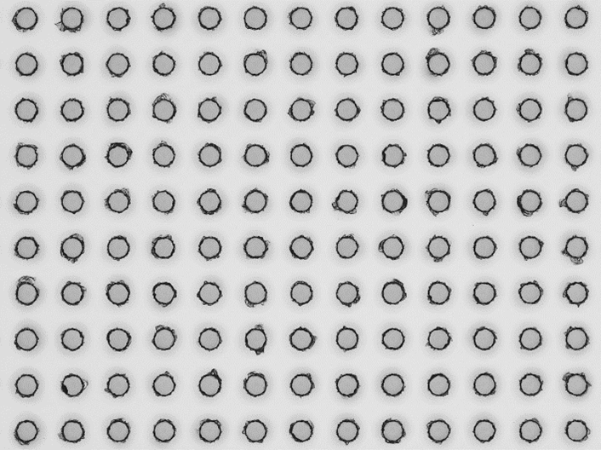
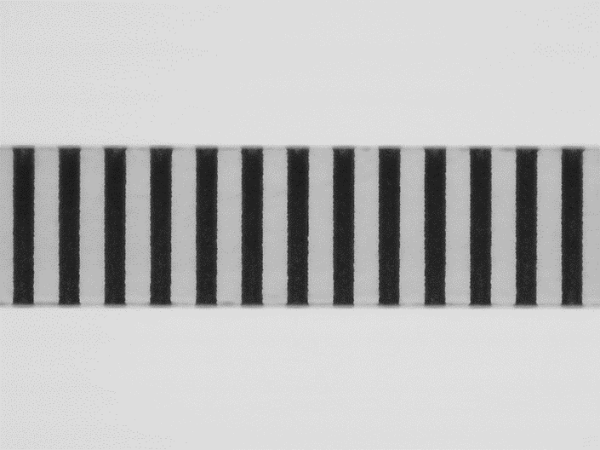
Left: top view of 100µm diameter laser drilled holes; Right: Cross section of laser drilled holes
Laser-Induced Etching (LIE)
Laser-induced etching is a technique that combines elements of laser ablation and chemical etching. It involves using a laser beam to locally heat the glass surface, followed by a chemical etchant that selectively reacts with the heated regions, resulting in hole formation. This technique is especially effective for creating ultra smooth hole surfaces and intricate structures.
The main reason for choosing this process would be when having a design with a high hole density. The laser can shoot at high speed the holes followed by an etching process at batch level. Especially for a high quantity of holes this results in a higher speed as normal laser drilling.
Advantages of laser induced etching
- Selectivity: Laser-induced etching allows for selective hole formation, offering control over the location and size of the holes.
- High aspect ratio: This technique enables the creation of holes with high aspect ratios (depth-to-diameter ratio), making it suitable for specific applications. 1:100 can be achieved with this process with a minimum diameter of 10µm, even with possibilities to go lower.
- Compatibility with complex patterns: Laser-induced etching can be used to create holes in intricate and complex patterns, expanding its applicability.
- Smoothness: The holes have no chipping and have very smooth walls. See image below.
Limitations of laser induced etching
- Process complexity: Laser-induced etching requires careful optimization of laser parameters and chemical etchants, making it a more intricate process compared to other techniques.
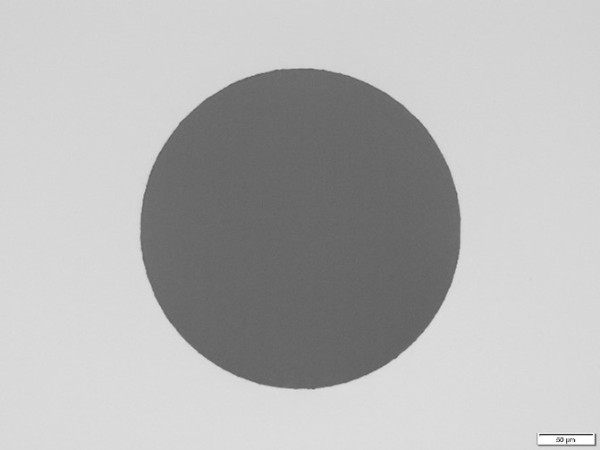
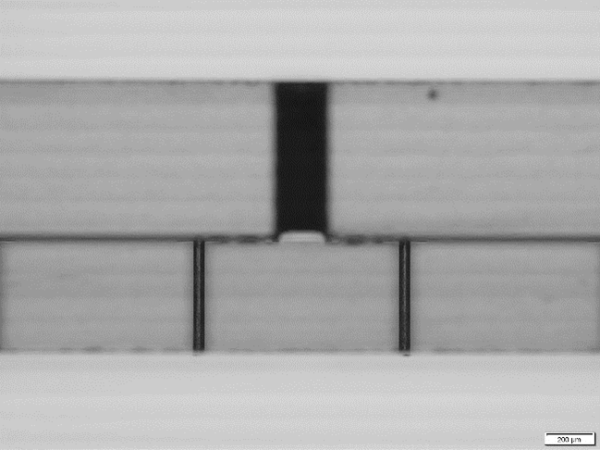
Left: 250µm diameter holes laser induced etched; Right: Cross section of laser induced etched holes
Considerations for Choosing the Right Method:
When selecting the optimal technique for creating holes in your microfluidic products, there are several key factors to consider:
- Hole Size and Shape: Depending on your microfluidic device's application, you may need to create specific hole sizes and shapes. For example, powderblasting is suitable for creating tapered holes.
- Material: The material of your microfluidic device can influence the choice of hole-making method. Some techniques are better suited for certain materials. Laser drilling, for example, is effective for a wide range of materials but is so far not possible yet with Fused Silica or Quartz.
- Production Cost: The cost of producing your microfluidic device can vary depending on the chosen technique. Powder blasting is generally less expensive than laser-induced etching but has limitations in terms of hole size, shape and quality.
- Production Volume: If you plan to produce large quantities of microfluidic devices, the choice of hole-making method can affect the production speed and efficiency.
Conclusion: Choosing the Right Method for Your Microfluidic Products
Selecting the appropriate technique for creating holes in your microfluidic products depends on various factors, such as the desired hole shape, size, roughness, and production cost. At Micronit, we have the expertise to help you choose the optimal method based on your specific needs and requirements. With our comprehensive knowledge of powder blasting, laser drilling, and laser-induced etching, we can create the perfect holes for your microfluidic products with ease and precision. Contact us to discover how we can support you in realizing your microfluidic designs and bridging the gap between design and reality.